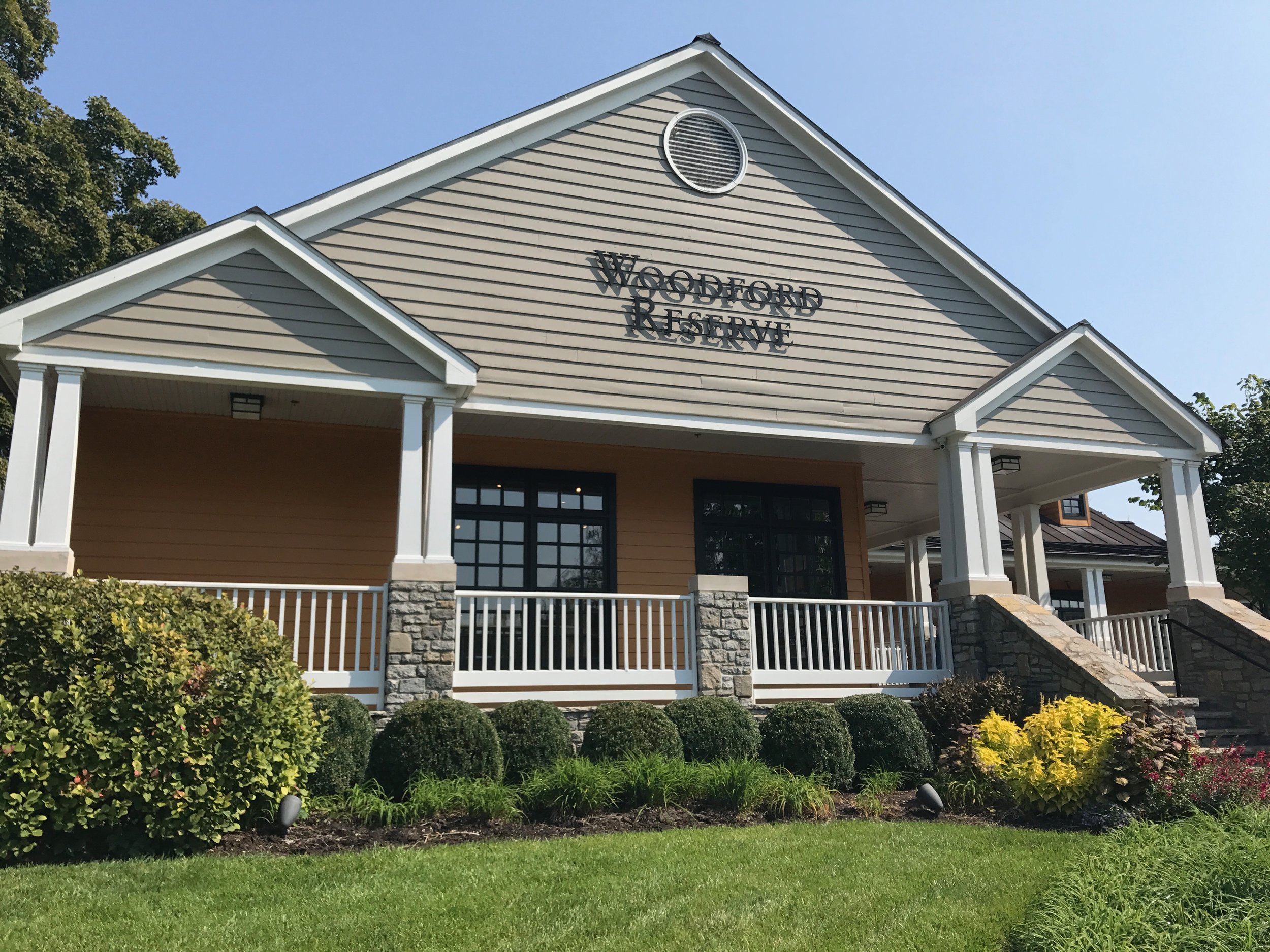Woodford Reserve
Kentucky Straight Bourbon Whiskey
Written by Brian Donnelly, CSS, WSET III
Photo by Brian Donnelly
Photo by Brown-Forman (BAR+)
History
Woodford Reserve is without a doubt one of the most popular bourbons at the premium price point. American Whiskey giant, Brown-Forman, launched the brand in 1996. The site of the present-day distillery in Versailles, Kentucky, can trace its distilling roots back to 1797, when Elijah Pepper arrived in Versailles and began distilling corn into whiskey. Elijah Pepper moved his operation to the current Woodford Reserve site at Glenn’s Creek in 1812. In 1835, Oscar Pepper, Elijah’s son, took over the distillery and hired a Scottish Scientist named Dr. James C. Crow to become the head distiller. Dr. Crow is often credited with introducing the practice of using sour mash in the fermentation process. The distillery was purchased in 1878 by a French wine merchant named Leopold Labrot and a Kentucky businessman named James Graham. The distillery remained in the Labrot family until 1940 when Brown-Forman purchased it for the first time. With the decline in the bourbon category, Brown-Forman sold off Labrot and Graham Distillery in 1971, only to repurchase the same distillery in 1994. Brown-Forman would name their new bourbon after Woodford County, the country in which it is produced. In 2005, the Labrot and Graham Distillery was renamed the Woodford Reserve Distillery and is recognized as the oldest distillery in Kentucky. The distillery was designated a National Historic Landmark in 2000. Located an hour east of Louisville, in between Frankfort and Lexington, the Woodford Reserve is one of the most beautiful distilleries to tour on the Kentucky Bourbon Trail.® I would highly recommend visiting.
Photo by Brian Donnelly
Photo by Brian Donnelly
The Five Sources of Flavor
Next, we will examine the production process through what Master Distiller Chris Morris calls the five sources of flavor. This includes water, grain, fermentation, distillation, and maturation. Each step is a crucial building block to create the final flavor profile for Woodford Reserve Bourbon.
The part of the United States where Kentucky is located sits on a limestone shelf, which gives the local bourbon producers access to great natural water. The present-day Woodford Reserve Distillery was explicitly built at the site of Glenn’s Creek because it is a source of pure limestone-filtered water, which is extremely important in every aspect of production bourbon production. Water is used during fermentation, after distillation to lower the proof of the new make spirit, and after maturation to reach bottling proof—limestone filters out iron, which can destroy bourbon flavor. The limestone-filtered water is also full of rich minerals, such as magnesium, zinc, and potassium, vital for fermentation.
Woodford is a high-rye bourbon made with 72% corn, 18% rye, and 10% malted barley.
Next, the ground grains are combined in large 7,500 gallon Cypress Vats with the iron-free spring water and a proprietary yeast strain called 72B, which was specially developed for the Woodford Reserve brand. The combination of the mash bill and yeast strain is known as the recipe. Brown-Forman’s four major American Whiskey’s, Old Forester, Cooper’s Craft, Jack Daniel’s, and Woodford Reserve, have their unique yeast strain, contributing to each brand's different flavor profiles.
Woodford has a 5-7 day fermentation duration, which is long for the category and allows the mash to develop a more complex range of flavors, and the particular yeast strain brings out more fruit and ester notes. The brand also uses a lower sour mash percentage, between 1-6%. You’ve probably seen the term sour mash on a bourbon label and never knew what it means. The sour mash technique adds “backset,” or the highly acidic residue that comes out of the base of the beer still after distillation to the next round of fermentation. This acidic residue maintains the PH levels during fermentation, provides consistency, and adds flavor. Most commercial American Whiskey distilleries employ the sour mash technique, but several choose not to include sour mash, which becomes known as “sweet mash.”
Woodford Reserve uses a unique distillation method compared to the rest of the category. The brand uses a combination of pot still and column still distillate. The pot still distillate is tripled distilled in three large copper pot stills imported from Scotland. The column still distillate is double distilled in a standard Vendome Column Beer Still at the Brown-Forman Distillery in Shively, Kentucky. The two different distillates mature separately, then mingle together at bottling for a constant product. The new make spirit comes off the still at 158 proof ( 79% ABV) and is cut down to a barrel entry proof of 110 proof (55% ABV).
It is impossible to talk about any Brown-Forman product without discussing the importance they place on their barrels. Like Brown-Forman’s other bourbon brands, all barrels used to age Woodford Reserve bourbon are produced exclusively from one of the Brown-Forman Cooperages. The maturation process takes place in picturesque grey brick and stone rackhouses on-site at the distillery. Every rack house is heat-cycled year-round to allow the developing bourbon the maximum amount of mingling with the charred oak. The Woodford Reserve Distillery operates one of the oldest steam-heated rackhouses in the state of Kentucky. The famous Colonel E.H. Taylor Jr. is credited with inventing using steam to heat-cycle the rackhouses. Still, this technique has ultimately died off except for a few distilleries. Most Kentucky distillers do not heat-cycle their aging facilities. Instead, they use traditional open-air rack houses, hot in the summer and cold in the winter.
The new white oak American barrels are first lightly toasted, then heavily charred. Woodford does not carry an age statement but instead is aged to taste and bottled from many barrels of different ages and flavor profiles. The base expression is bottled at 90.4 proof (45.2% ABV).
Now let’s examine some of the Woodford line extensions.
Photo by Brown-Forman (BAR+)
Woodford Reserve Distiller’s Select
90.4 Proof (45.2% ABV)
Mash Bill: 72% Corn, 18% Rye, 10% Malted Barley
Established in 1996
Woodford Reserve Double Oaked
Mash Bill: 72% Corn, 18% Rye, 10% Malted Barley
First released in 2012, the Woodford Reserve Double Oaked is an incredibly rich and complex product. This expression takes fully mature regular Woodford Reserve, and ages it in a second new barrel that has been heavily toasted and then lightly charred for an additional 6-12 months. The second barrel receives the exact inverse toasting and charring of the first barrel. The additional aging produces a considerably darker color. This expression is also bottled at 90.4 (45.2% ABV).
Woodford Reserve Rye
First released in 2016, the Woodford Reserve Rye has a mash bill is 53% rye, 33% corn, and 14% malted barley. This expression has a very low rye percentage, just over the 51% legal minimum to be called a rye whiskey, so this would be the perfect rye whiskey for bourbon drinkers who don’t think they like rye. This expression is also bottled at 90.4 (45.2% ABV).
Woodford Reserve Malt
First released in 2018, the Woodford Reserve Malt is a throw back to a pre-prohibition style of Kentucky malt whiskey. Coming out of Prohibition the Federal Government approved four straight whiskey standards: Bourbon, Rye, Wheat, and Malt. These reflect the types of whiskeys produced in the United States prior to Prohibition. While most people associate Malt Whiskey with Scotland, Kentucky has a history of Malt Whiskey production pre-Prohibition. The mash bill is 51% malted barley, 47% corn, and 2% rye. This expression is also bottled at 90.4 (45.2% ABV).
Woodford Reserve Wheat
First released in 2019, this new expression from Woodford Reserve is not a wheated bourbon. It is instead a true four grain wheat whiskey from Kentucky. Wheat is the dominate grain with a mash bill of 52% wheat, 20% corn, 8% rye, and 20% malted barley. This expression is also bottled at 90.4 (45.2% ABV).
Photo by Brian Donnelly
Photo by Brian Donnelly
Master’s Collection, Batch Proof, & Conclusion
The brand also releases several limited-time offer products every year. Around the Christmas holidays, Woodford releases their Master’s Collection, which changes every year, and allows the brand to play with different styles, flavors, and production methods. There is also their batch proof, which is their annual barrel proof release. Availability for the Master’s Collection and Batch Proof are usually limited in most markets. In conclusion, I’m a huge fan of the Woodford Reserve brand, because it’s complex, versatile, and deliveries excellent value for the money to the consumer. In my “Best Bourbon Series,” Woodford Reserve was my pick for the best bourbon between $30 and $40, just barley beating out Russell’s Reserve 10 Year. As the brand continues to gain popularity, grow, and innovate, I’m excited to see what the future holds for Brown-Forman, Master Distiller Chris Morris, and the Woodford Reserve Family of Brands.
Please Drink Responsibly.
©2021 Brown-Forman
Support The Spirits Educator
If you would like to support the content here, please click the button below to buy me a cocktail or neat pour through PayPal. You can also use Venmo @thespiritseducator.
Thank you for your support!
Affiliate Disclosure
The links for product recommendations in this post are affiliate links. At zero cost to you, I will earn an affiliate commission if you click through the link and finalize a purchase. This helps support this channel so that I can continue to bring you new content.
















